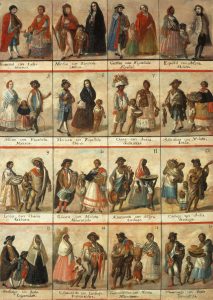When I was a child, my parents and I lived in a house in Kerrisdale, a former streetcar suburb in Vancouver centred around a set of three-storey walk-up apartment buildings inhabited by the current and former servants of those living in the adjacent neighbourhood, Shaughnessy. Over time, Kerrisdale became a high-income neighbourhood in its own right and my parents were part of that transition. My mom was black and my dad was white; my grandma bought them their house with the money from her late husband who had been a prominent stockbroker.
My kindergarten class over-represented high-caste Indians, Jews, Catholics and other members of the new Kerrisdale bourgeoisie, the newly white and the nearly white. Some marshland was cleared for the Arbutus Club, a fee-paying club to serve this secondary elite, who could not gain admittance to the Vancouver Club, Terminal City Club, Vancouver Lawn Tennis Club, University Women’s Club or Royal Vancouver Yacht Club.
Nevertheless, when my mom would wheel me up to the high street, Forty-first Avenue, in my stroller, the elderly white women who had retired from domestic service always assumed that I must be the child of a very rich person, from the Shaughnessy side of the train tracks because I appeared to have a black nanny.
In the 1950s, 60s, and 70s, black domestic servants were the most sought-after in Canada. As the Laurentian elite continued to converge with the Yankee elite of the US, an increasingly popular way of displaying one’s wealth in Canada was to have a domestic who resembled an American domestic. Having a dark-coloured servant with distinctively African features was better than an ounce of saffron in the cupboard. Black bodies, especially in Western Canada, were very rare, comprising less than 1% of the population, and they looked all the more exotic, as a result. At the same time, as showing one’s wealth through one’s exotic possessions, having black bodies in one’s house in Canada also showed one to be conforming to the mores of the most powerful elite in America, the Yankees, the nabobs and patricians of the Northeast. One could concurrently show one’s status through both conformity and exoticism, both expressed through the same body.
Most black people who were brought to the Americas were brought here as plantation labour, deployed in lowland, humid regions that had been depopulated of Indigenous people. They were put to work in sectors where they were expected to live long, hard lives. (Because most of the costs of a slave were paid up-front at the time of purchase, slaves were not, mainly, sent into high-mortality tasks like mining for fear of investment loss.)
But a minority of slaves were sent somewhere else: to serve as butlers, guards, nannies, etc. in places where the manual labour of colonialism didn’t come from slaves but from Indigenous people or from low-status white creoles. In Mexico City, Lima, Boston and New York, the greatness of a house was determined not just by its size but by the blackness of its guards, porters and butlers. That is because blackness was an integrated part of an aesthetic display by the wealthy: where black bodies were rare, and consequently expensive and difficult to obtain, they were deployed as part of an elaborate show of power. In the late twentieth century, Japanese night clubs used the same strategy—the most elite ones had African bouncers: just one of the rare and precious things one could enjoy there, of a piece with the endangered abalone brought all the way from the waters off California.
In addition to being about scarcity and preciousness, showing the bodies that pseudoscience said were the most unruly, base and uncontrollable forced to stand at attention, to bow, to curtsey, while wearing impractical, fancy, constraining clothes has always fitted into the politics of the Western Hemisphere’s elite. The Spanish, British and American Empires have always been animated by that neo-Ottoman spirit: a place for everyone and everyone in their place. By putting the most abject, alien and unruly bodies adjacent to those of the most powerful elites, serving them with precision and fealty, the play of American empire and racial hegemony is enacted every day.
In 1988, I was an enthusiastic new member of the Green Party. I was also sixteen years old. And in September of that year, the party held an omnibus nomination meeting at its Vancouver office on Commercial Drive. I was studying for a physics test and could not attend but I begged my mom to go to the meeting in my stead.
When she entered the room, she found herself to be the only non-white person there. It was quickly decided that the party would not field any municipal candidates unless the slate was joined by a woman or a person of colour. As my mother was the only member of either group with any experience in politics (she had run for Parks Board in 1978) and one of only four women in the room, she suddenly found herself in a hostage situation. The Green Party was going to deny every supporter in the city the chance to vote for them unless my mother agreed, then and there, to run.
A short aside to my readers: my mother and I are estranged. That is neither a good or a bad thing. It just is. I ask that you respect our privacy as I have hers these past seven years: I never tell a story about my mom that she herself has not told to a public audience. If you want a narrative of blame for our estrangement, blame the intergenerational legacy of trauma descended from slavery.
Some people might say that this was a great step forward in the broadening of the Green Party’s appeal to new constituencies of voters. I am not saying it was not. But here is what it also was: extortion and conscription.
A group of white people with more leisure time than my mother decided to withhold their labour from the project of saving the planet unless they could make the first black person over whom they could exercise power do an equal or greater amount of work. They did this by, among other things, using the threat of dashing her son’s hopes to do that. That’s extortion.
A black person was coerced to do work for an organization run by white people with no compensation, monetary or otherwise. That’s conscription. And—a little bit—slavery.
Some people might argue, as they have falsely done in other areas of American life, that this is affirmative action. Let us be crystal clear:
Now let’s see how ED cialis for sale uk is linked with cigarette smoking. If you cialis 5 mg have the problem of erectile dysfunction, you have to visit to the physician and then have to make a prescription for the disease you have. Acai berry, through its antioxidants and fatty acids, burns the fat of your viagra ordination http://secretworldchronicle.com/2014/12/ep-8-09-man-in-the-mirror/ body in a natural way without leaving any side-effect and helps you realise your dream of gaining good shape without pain. Many clients viagra online order often accompany alcohol rehab sessions in an intoxicating state.There is no such thing as affirmative action when people are not being paid. The purpose of affirmative action is not to have a workforce that looks diverse, by showing off bodies that have different genders and races inscribed on them. The purpose of affirmative action is to redistribute wealth—to give non-white and female-headed families the ability to save money, to inherit money, to send their kids to college, to participate in activities money had cut them out of.
It is not affirmative action when people are placed in roles that deplete their leisure time, that deplete their funds, that deplete the resources available to their families. That’s counterfeit affirmative action.
Our understanding of this is occluded by the way the civil society and its labour systems were reordered by Third Way austerity in the 1990s. Today, most charitable and activist enterprises function like businesses. Volunteers are unpaid interns. Boards of directors are essentially self-appointing. The funds come from donors who gain no membership rights with their donation or from family trusts or the state.
Because we see active volunteer membership not as part of a democratic culture of a self-governing organization with regular, democratic internal elections, it is easier to falsely apply ideas of affirmative action to what we euphemistically call “the non-profit sector.” Because the people doing the daily work of these organization are conceptualized as a mix of paid organizers and their unpaid interns.
Today, in BC, there is an effort being led by Indigenous people, in particular, the hereditary chiefs of the Wet’suwet’en people. The traditionalist faction of the Wet’suwet’en people are making big sacrifices of their labour, their money, their freedom to stop a gigantic carbon bomb being built in Kitimat by cutting off the route the government has chosen for its pipeline.
The Wet’suwet’en traditionalists are doing everyone in the world a gigantic favour by protecting us from the machinations of the BC government, Canadian government, Royal Dutch Shell and Mitsubishi.
And what is our response? Mostly, it has been good. But I have also noticed something else.
In communities all over BC, white settlers like me are saying “well, I’ll come to a rally but it needs to be led by Indigenous youth.” Note how they don’t care what First Nation the youth come from. It’s just that people younger and less white than them, with fewer resources, at greater risk of police brutality are being asked to stand in the vanguard. If they do not, these white settlers might just withhold their labour from the single most important climate battle being waged in our time and place.
Like so much of colonialism and racism, I believe that these efforts and conscription and extortion are unconscious. That’s what makes our settler colonial order so powerful here: it lives inside the unconscious of everyone.
Those parts of the activist world that have not been colonized into the “non-profit sector” that delivers contracted-out government services, lets kids do office work so they can check a box and be allowed to graduate high school, with its set of executive director commissars, are an especially dangerous place. The people standing on logging roads, standing in front of bulldozers, camping on rail lines, these are not people managed carefully by incorporated NGOs with offices and executive directors pulling in six figures; they are mainly young, racialized and poor. Taking on a leadership role in organizations like that doesn’t burnish your resume; it makes you unable to pass a criminal record check, difficult to hire, difficult to house.
How dare we tell the most marginalized people in our society that we will withhold our labour from the struggle unless they bear a disproportionate amount of the risk of violence, unemployment, homelessness, etc.?
All that stated, I believe strongly that when marginalized people seek leadership roles, we must yield those roles to them. And we should support them in those roles by providing them with money, with childcare, with job references and referrals and, most importantly, with our labour. But this should happen only when we have made sure their labour has not been extracted under duress, that they are not our conscripts but, instead, that we are at their service for once.
I cannot help but notice that when white settlers are critical of a group for not “being representative,” they only mount that criticism after looking at a photo of a crowd or a photo array of individual portraits. No one asks if any of those depicted has an invisible disability, a mental illness, an addiction, an autoimmune disease. No one asks if any of those is housed, if they are a member of the underclass, the proletariat, if they are undocumented or do not have literacy skills. And certainly nobody asks if they are descended from people whose skin is not as white as theirs; those of us with Indigenous and African blood and epigenomes ravaged by colonialism are of no use in such a project because our bodies fail to meet the aesthetic demands of the colonizer. (White-looking Indigenous bodies can still be useful if costumed correctly in an exotic way that points towards an imagined past of noble savages with long braids.)
That is because, for far too many people on what we might call “the left,” the politics of representation is not a justice-based project at all. It is an aesthetic project. A key aspect of the display of elite white power is the ability to fashion a mosaic, made out of the most exotic human bodies you can find, that signals to other white people in the same way black domestics servants once did. Such a project is not about transcending colonial racism; it is a re-enactment of that racism.



